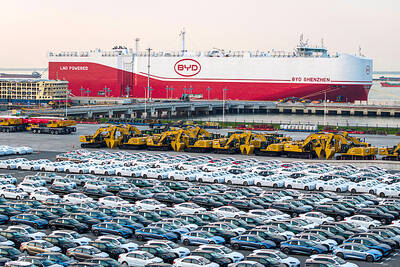The nation’s global competitiveness ranking remained unchanged at No. 13 this year, supported by strong business innovation and improving financial market developments, despite weak labor market efficiency and worsening government finances, a report by the World Economic Forum (WEF) showed yesterday.
The Global Competitiveness Report 2011-2012 by the Geneva-based independent organization ranked Switzerland as the most competitive among 142 economies, followed by Singapore, Sweden, Finland and the US.
Regionally, Taiwan ranked fourth behind Singapore, Japan and Hong Kong, but outperformed South Korea. Japan ranked ninth, while Hong Kong and South Korea were at No. 11 and No. 24 respectively, the report said.
Countries are evaluated based on 111 factors that fall under 12 main categories: institutions, infrastructure, macroeconomic environment, health and primary education, higher education and training, goods market efficiency, labor market efficiency, financial market development, technological readiness, market size, business sophistication and innovation.
“The study showed that Taiwan placed first in eight detailed factors, with 37 of its factors marking their highest levels in history, an indication that the nation’s global competitiveness remains strong,” Council for Economic Planning and Development Minister Christina Liu (劉憶如) told a media briefing.
Taiwan placed first in utility patents granted — the fourth straight year it topped the list — demonstrating local companies’ continuing efforts on innovation, Liu said, citing the WEF’s statement.
In terms of financial market development, Taiwan moved up 11 notches to No. 24, with affordability of financial services and financing through local equity market ranking first and second respectively.
However, Taiwan ranked 118th in “rigidity of employment index” and “redundancy costs,” indications that labor market efficiency remained an important issue for the nation.
“The government should carefully consider how to balance the flexibility between the employers and employees,” Liu said.
The government budget balance ranked No. 91, down from No. 68 a year earlier, with the ranking of general government debt dropping five notches to 71st. Both factors were a drag on the nation’s macroeconomic environment, the report said.
Liu attributed these worsening rankings to the government’s strategy of spurring domestic demand by granting consumption vouchers in 2009, as the WEF said in the report that the evaluations on government finance were made based on 2009 data.
“These rankings may rebound next year, further driving up the nation’s overall global competitiveness ranking,” she said.
The Ministry of Finance published the latest Web-based “National Debt Clock” yesterday, with the national debt working out to NT$204,000 per person as of the end of last month, down NT$1,000 per person from a month earlier.

Micron Memory Taiwan Co (台灣美光), a subsidiary of US memorychip maker Micron Technology Inc, has been granted a NT$4.7 billion (US$149.5 million) subsidy under the Ministry of Economic Affairs A+ Corporate Innovation and R&D Enhancement program, the ministry said yesterday. The US memorychip maker’s program aims to back the development of high-performance and high-bandwidth memory chips with a total budget of NT$11.75 billion, the ministry said. Aside from the government funding, Micron is to inject the remaining investment of NT$7.06 billion as the company applied to participate the government’s Global Innovation Partnership Program to deepen technology cooperation, a ministry official told the

Taiwan Semiconductor Manufacturing Co (TSMC, 台積電), the world’s leading advanced chipmaker, officially began volume production of its 2-nanometer chips in the fourth quarter of this year, according to a recent update on the company’s Web site. The low-key announcement confirms that TSMC, the go-to chipmaker for artificial intelligence (AI) hardware providers Nvidia Corp and iPhone maker Apple Inc, met its original roadmap for the next-generation technology. Production is currently centered at Fab 22 in Kaohsiung, utilizing the company’s first-generation nanosheet transistor technology. The new architecture achieves “full-node strides in performance and power consumption,” TSMC said. The company described the 2nm process as

Shares in Taiwan closed at a new high yesterday, the first trading day of the new year, as contract chipmaker Taiwan Semiconductor Manufacturing Co (TSMC, 台積電) continued to break records amid an artificial intelligence (AI) boom, dealers said. The TAIEX closed up 386.21 points, or 1.33 percent, at 29,349.81, with turnover totaling NT$648.844 billion (US$20.65 billion). “Judging from a stronger Taiwan dollar against the US dollar, I think foreign institutional investors returned from the holidays and brought funds into the local market,” Concord Securities Co (康和證券) analyst Kerry Huang (黃志祺) said. “Foreign investors just rebuilt their positions with TSMC as their top target,

POTENTIAL demand: Tesla’s chance of reclaiming its leadership in EVs seems uncertain, but breakthrough in full self-driving could help boost sales, an analyst said Chinese auto giant BYD Co (比亞迪) is poised to surpass Tesla Inc as the world’s biggest electric vehicle (EV) company in annual sales. The two groups are expected to soon publish their final figures for this year, and based on sales data so far this year, there is almost no chance the US company led by CEO Elon Musk would retain its leadership position. As of the end of last month, BYD, which also produces hybrid vehicles, had sold 2.07 million EVs. Tesla, for its part, had sold 1.22 million by the end of September. Tesla’s September figures included a one-time boost in